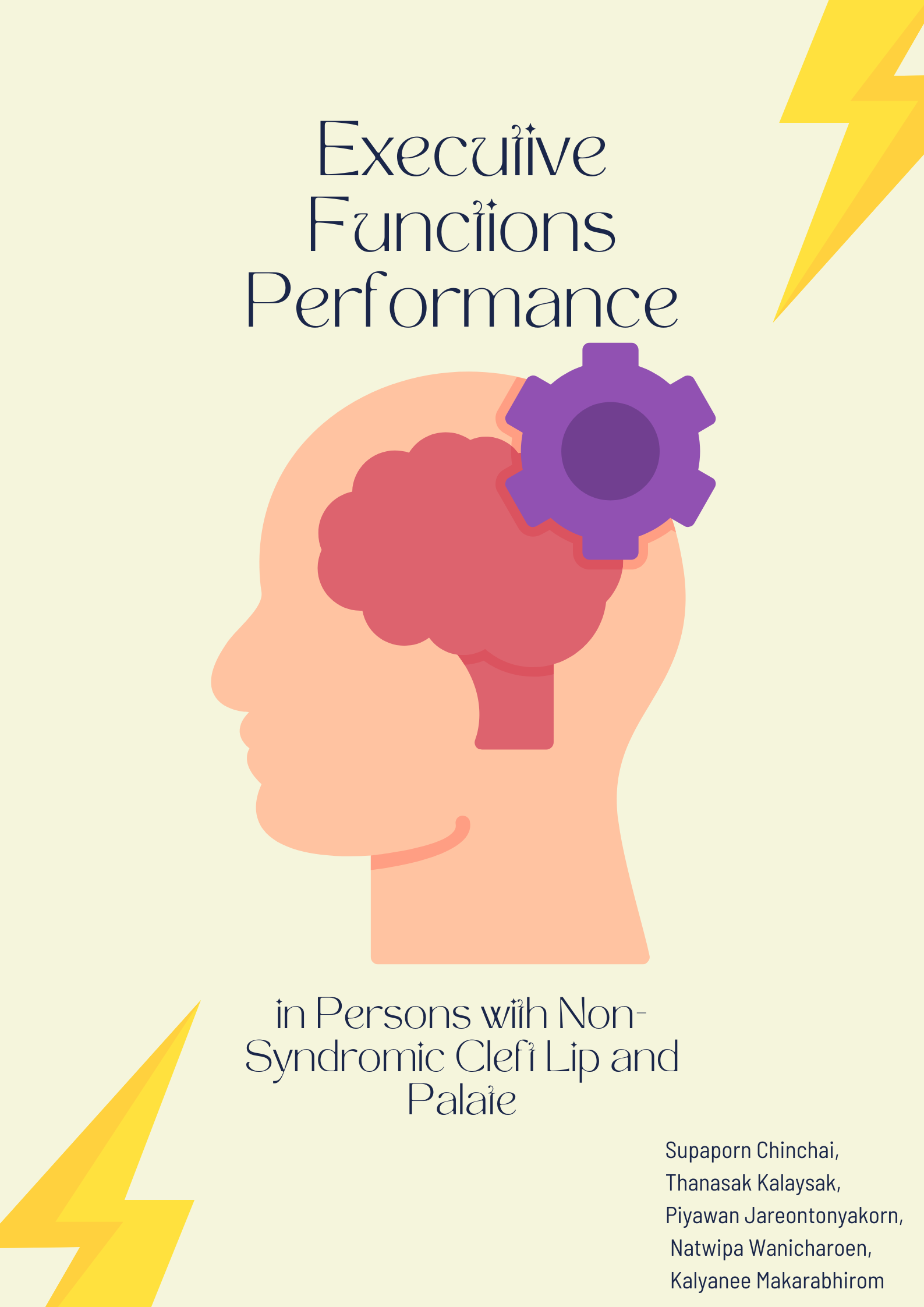Executive function performance in persons with non-syndromic cleft lip and palate
Main Article Content
Abstract
Background: Executive functions (EFs) are crucial cognitive functions that mature from birth to adolescence. They are vital for daily task execution and overall success and also influence language and communication development. Children with EFs deficits often experience delays in language and speech abilities. These impairments are particularly prevalent among individuals with cleft lip and palate. Consequently, speech and language pathologists must address these impairments through assessments and interventions. Despite this urgent need for action, there is a scarcity of research on executive function performance in this population in Thailand, prompting an investigation to address this issue. This study explores executive function performance in this population to enhance the quality of life for individuals with cleft lip and palate.
Materials and methods: Using a survey-based approach, executive function performance was assessed in 5- to 15-year-old volunteer with non-syndromic cleft lip and palate attending the speech therapy camp provided by the Princess Sirindhorn IT Foundation Craniofacial Center at Chiang Mai University in April 2024. Parents completed the Behavior Rating Inventory of Executive Function (Parent form), with scores ≥65 indicating executive function difficulties.
Results: The study involved 29 participants, 14 males (48.28%) and 15 females (51.72%), with a mean age of 8 years and 9 months. Average scores for executive function abilities in BRI, MI, and GEC were 52.21, 56.48, and 58.90, respectively. There are several participants with abnormal executive function in each age group, along with their average T-scores across different domains. Children aged 5, 6-8, and 9-11 have T-scores for executive function performances falling into problematic levels for 1, 2, and 5 individuals, respectively.
Conclusion: Most of the sample group demonstrated executive function skills within the normal range. However, a certain number of individuals experienced issues with executive function. These findings offer guidance for speech and language pathologists and emphasize the importance of executive function in individuals with cleft palates.
Article Details

This work is licensed under a Creative Commons Attribution-NonCommercial-NoDerivatives 4.0 International License.
Personal views expressed by the contributors in their articles are not necessarily those of the Journal of Associated Medical Sciences, Faculty of Associated Medical Sciences, Chiang Mai University.
References
Diamond A. Executive functions. Annu Rev Psychol. 2013; 64: 135-68. doi: 10.1146/annurev-psych-113011-143750.
Gioia, G.A. et al. Professional Manual Behavior Rating Inventory of Executive Function. Florida: Psychological Assessment Resources; 2000.
Chutabhakdikul N. Executive function. Srinakharinwirot Univ J Educ Stud. 2014; 48: 62-9.
Chutabhakdikul N. Executive functions and readiness for learning in preschool children. In: EDUCA 2015: The 8th Education Symposium for Teacher Professional Development; 2015; Nonthaburi. p. 35-8.
Friedman L, Sterling A. A Review of Language, Executive Function, and Intervention in Autism Spectrum Disorder. Semin Speech Lang. 2019; 40(4): 291-304. doi: 10.1055/s-0039-1692964.
Cascia J, Barr JJ. Associations Among Vocabulary, Executive Function Skills and Empathy in Individuals with Autism Spectrum Disorder. J Appl Res Intellect Disabil. 2017; 30(4): 627-37. doi: 10.1111/jar.12257.
Akbar M, Loomis R, Paul R. The interplay of language on executive functions in children with ASD. Res Autism Spectr Disord. 2013; 7(3): 494-501. doi: 10.1016/j.rasd.2012.09.001.
Gilotty L, Kenworthy L, Sirian L, Black DO, Wagner AE. Adaptive skills and executive function in autism spectrum disorders. Child Neuropsychol. 2002; 8(4): 241-8. doi: 10.1076/chin.8.4.241.13504.
McEvoy RE, Rogers SJ, Pennington BF. Executive function and social communication deficits in young autistic children. J Child Psychol Psychiatry. 1993; 34(4): 563-78. doi: 10.1111/j.1469-7610.1993.tb01036.x.
Perrone-Bertolotti M, Tassin M, Meunier F. Speech-inspeech perception and executive function involvement. PLoS One. 2017; 12(7). doi.org/10.1371/journal.pone.0180084.
Bodoni PSB, Leoni RF, do Vale AB, da Silva PHR, Meira Junior SG, Richieri Costa A, Tabaquim MLM. Neuropsychological functioning and its relationship with brain anatomical measures of children and adolescents with non-syndromic cleft lip and palate. Child Neuropsychol. 2021; 27(1): 2-16. doi.org/10.1080/09297049.2020.1776240.
Li Z, Zhang W, Li C, Wang M, Wang S, Chen R, Zhang X. Articulation rehabilitation induces cortical plasticity in adults with non-syndromic cleft lip and palate. Aging (Albany NY). 2020; 12(13): 13147-59. doi. org/10.18632/aging.103402.
Conrad AL, Richman L, Nopoulos P, Dailey S. Neuropsychological functioning in children with non-syndromic cleft of the lip and/or palate. Child Neuropsychol. 2009; 15(5): 471-84. doi.org/10.1080/09297040802691120.
Thai Health Promotion Foundation. Development and standardization of assessment tools for executive function in preschool children [Internet]. 2017 [cited 2023 Sep 8]. Available from: http://kb.hsri.or.th/dspace/handle/11228/4650?locale-attribute=en.
Center on the Developing Child at Harvard University. Building the brain’s “air traffic control” system: How early experiences shape the development of executive function: Working paper no. 11 [Internet]. 2011 [cited 2023 Sep 10]. Available from: https://developingchild.harvard.edu/wp-content/uploads/2011/05/How-Early-Experiences-Shapethe-Development-of-Executive-Function.pdf.
Sarakai S. The study of executive function in children aged 7-12 years old using Behavior Rating Inventory of Executive Function (BRIEF) [Term paper]. Chiang Mai University; 2017. Available from: http://202.28.25.187/termpaper/termrequest/fulltext/2560/OT1291.pdf.
O’Meagher S, Norris K, Kemp N, Anderson P. Parent and teacher reporting of executive function and behavioral difficulties in preterm and term children at kindergarten. Appl Neuropsychol Child. 2020; 9(2): 153-64. doi: 10.1080/21622965.2018.1550404.
Germano GD, Brito LB, Capellini SA. The opinion of parents and teachers of students with learning disorders regarding executive function skills. Rev CEFAC. 2012; 19(5): 674-82. doi: 10.1590/1982-0216201719510817.
Prathanee B. Problems of language and speech disorders in individuals with cleft lip and palate. In: Prathanee B, editor. Language speech and auditory in individuals with cleft lip and palate: Screening. Khon Kaen: Department of Otolaryngology, Faculty of Medicine, Khon Kaen University; 2008. p. 11-24.
Sándor-Bajusz KA, Dergez T, Molnár E, Hadzsiev K, Till Á, Zsigmond A, Vástyán A, Csábi G. Cognitive functioning and clinical characteristics of children with non-syndromic orofacial clefts: A case-control study. Front Psychol. 2023; 14: 1115304. doi: 10.3389/fpsyg.2023.1115304.


